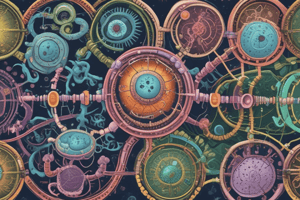Podcast
Questions and Answers
Match the following components involved in the process of photosynthesis with their roles:
Match the following components involved in the process of photosynthesis with their roles:
Electron = Moves down a series of protein complexes Proton = Forms a hydrogen atom when combined with an electron Chlorophyll = Loses electrons which are replaced during the process NADP = Gets reduced by the hydrogen atom to form reduced NADP
Match the following events in the thylakoid membrane during photosynthesis with their outcomes:
Match the following events in the thylakoid membrane during photosynthesis with their outcomes:
Pumping of protons by electron energy = Creates a proton gradient from stroma to thylakoid space Diffusion of protons through ATP synthase = Drives the process of photophosphorylation Absorption of light by PSI = Causes the electron to move to a high energy level Formation of hydrogen atom from electron and proton = Used in reducing NADP to form reduced NADP
Match the following terms related to photosynthesis with their definitions:
Match the following terms related to photosynthesis with their definitions:
Stroma = Region where protons move to create a proton gradient Thylakoid space = Region with high concentration of protons due to proton pumping Photophosphorylation = Process driven by protons diffusing through ATP synthase ATP synthase = Enzyme responsible for phosphorylating ATP from ADP and Pi
Match the following processes in photosynthesis with their descriptions:
Match the following processes in photosynthesis with their descriptions:
Match the following phases of photosynthesis with their descriptions:
Match the following phases of photosynthesis with their descriptions:
Match the following molecules with their roles in photosynthesis:
Match the following molecules with their roles in photosynthesis:
Match the following terms with their definitions:
Match the following terms with their definitions:
Match the following respiratory processes with their descriptions:
Match the following respiratory processes with their descriptions:
Match the following molecules with their respective quantities produced per molecule of glucose:
Match the following molecules with their respective quantities produced per molecule of glucose:
Match the following statements with the correct process in oxidative phosphorylation:
Match the following statements with the correct process in oxidative phosphorylation:
Match the following terms with their descriptions in oxidative phosphorylation:
Match the following terms with their descriptions in oxidative phosphorylation:
Match the following components with their actions in oxidative phosphorylation:
Match the following components with their actions in oxidative phosphorylation:
Match the following terms with their descriptions:
Match the following terms with their descriptions:
Match the following equations with their meanings:
Match the following equations with their meanings:
Match the following terms with their roles in ecosystem energy flow:
Match the following terms with their roles in ecosystem energy flow:
Match the following terms with their definitions:
Match the following terms with their definitions:
Match the following stages with their descriptions:
Match the following stages with their descriptions:
Match the following products with their corresponding enzymes:
Match the following products with their corresponding enzymes:
Match the following statements with the correct process in the nitrogen cycle:
Match the following statements with the correct process in the nitrogen cycle:
Match the following facts with the correct organisms involved in the nitrogen cycle:
Match the following facts with the correct organisms involved in the nitrogen cycle:
Match the following terms with their outcomes in the nitrogen cycle:
Match the following terms with their outcomes in the nitrogen cycle:
Flashcards are hidden until you start studying
Study Notes
Light-Dependent Reactions
- When water is split, 1 molecule of oxygen, 4 protons, and 4 electrons are produced
- Oxygen either diffuses out through stomata or is used in respiration
- 4 protons move into the stroma, creating a proton gradient
- The excited electron moves down a series of protein complexes, pumping protons from the stroma to the thylakoid space
- The electron then moves to PSI, where more photons of light are absorbed, causing the electron to move back up to a high energy level
Light-Independent Reactions (Calvin Cycle)
- Carbon dioxide fixation: CO2 is fixed with ribulose bisphosphate (RuBP) in a process known as carboxylation
- Reduction phase: the reducing power of reduced NADP reduces glycerate-3-phosphate, forming 2 molecules of triose phosphate
- Regeneration of RuBP: 5 molecules of triose phosphate are used to regenerate 3 molecules of ribulose bisphosphate
- Organic molecule production: 2 molecules of triose phosphate combine to form the intermediate hexose sugar fructose 1,6 bisphosphate
Respiration
- Aerobic respiration: splitting of a respiratory substrate, releasing carbon dioxide as a waste product
- Anaerobic respiration: occurs in the absence of oxygen
- Oxidative phosphorylation: process by which energy from NADH and FADH is used to pump protons across the mitochondrial membrane
- Krebs cycle: 2 ATP molecules, 6 NADH molecules, 2 FADH molecules, and 4 CO2 molecules are produced per molecule of glucose
Photosynthesis
- Net primary productivity (NPP): rate at which energy is transferred into organic molecules, minus respiratory losses to the environment
- Gross primary productivity (GPP): rate at which energy is incorporated into organic molecules in photosynthesis
- NPP = GPP – R
Nutrient Cycles
- Nitrogen cycle: nitrogen is recycled within natural ecosystems, with four stages:
- Ammonification: microbes break down organic matter to ammonia
- Nitrification: nitrifying bacteria convert ammonia to nitrite ions
- Denitrification: nitrate ions are converted to nitrogen gas
- Nitrogen fixation: nitrogen gas is fixed into other compounds by bacteria with nitrogen-fixing ability
Studying That Suits You
Use AI to generate personalized quizzes and flashcards to suit your learning preferences.




